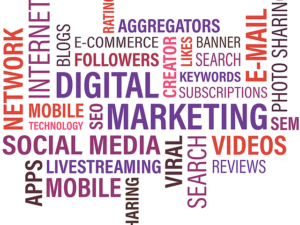
What is Demand Generation?
Marketing your business can feel like an uphill battle, but it comes down to getting your target audience interested in what you’re selling.
What’s the best way to do that? By changing their perspective so they understand not only what you do, but what problem you solve. Help them see that what you offer is what they need to create a demand for your products or services.
This process is called demand generation, or demand gen for short.
If you do it well, demand generation can raise awareness among desired audiences, provide your sales team with more qualified leads, and help your marketing efforts generate revenue.
Demand Generation Overview
Demand generation is about generating interest in your products or services to build a healthy pipeline of qualified leads for your sales team.
It is a broad term that encompasses all marketing and sales initiatives at every stage of the sales funnel. By providing valuable information to the right audience at the right time, you can increase awareness and demand for your products and services.
The best demand generation strategies take into account every step in the customer’s journey, from the first interaction with your company to the moment the customer becomes a customer. Demand Generation initiatives should align your marketing and sales teams to help grow your business.
Why is demand generation important?
Demand generation is critical because it helps you position yourself differently with potential customers. Instead of focusing on selling your solution, Demand Generation creates awareness of a need.
When you make it clear to your audience that they have a need and how that need impacts their business, they are more likely to be receptive to subsequent sales messages.
If you want to grow your business, you need to develop a solid pipeline of new customers. Demand generation focuses on addressing customers’ needs and capturing their interest before you sell. By optimizing every touchpoint with your target audiences, you can increase the quality of leads you bring through the funnel.
Demand generation also helps generate interest and awareness, making you a trusted source of information. It helps you develop more thoughtful and cohesive marketing efforts to improve people’s experience when interacting with your company.
Demand generation vs. lead generation
Demand generation and lead generation are not quite the same thing. So let’s look at both to get an idea of where they overlap and where they differ.
They are similar in that they both have the goal of growing your business and increasing revenue, and both work to attract new customers to your business. However, the approach and immediate goals are quite different.
Lead generation, also known as lead gen, focuses on obtaining information from an individual in exchange for content. The goal is to obtain this contact information to facilitate contact and engagement for sales and marketing purposes.
Lead generation assumes that your target audience already knows they have a problem and are looking for a solution to a product or service in the marketplace. They are at a stage where they are ready to evaluate your business to see if you can help them solve an existing problem.
With lead generation, the focus is on getting contact information from potential customers, so there will likely be gated content or other opportunities to complete this transaction.
Demand Generation
Demand generation, sometimes referred to as demand generation, is more about attention and interest and how you can position your company as an important source of information.
This allows you to engage your target audiences to create awareness of a need and generate interest in your company. Hopefully, the result is that the more your target audience is interested in your company, the more receptive they will be when you interact with them.
If you get people excited about what you do, they will be more likely to reach out to you when they realize they have a need. To create demand for your product or service, you need to educate people about the challenges they face and help them understand why it’s worth investing resources in a solution.
Demand Generation casts a wider net, using unauthorized content to raise awareness of your brand and solutions. The goal is to increase visibility and interest in your work.
B2B demand generation strategies
What are signs that Demand Generation could help your business with its growth plans? Perhaps you recognize a need for more and better leads or higher customer retention. Maybe you recognize that better systems in your sales and marketing process could create a better experience for your customers.
Once you’ve created your B2B strategies, you realize how valuable demand generation can be. How can you make it happen?
Here are 10 strategies you can use to make it work for you.
1. Capture your ideal customers with buyer personas.
Creating buyer personas is an important starting point for targeting your marketing to specific audiences. These fictional profiles of your ideal customers can help you focus on who you need to reach and what they want to hear from you. A complete buyer persona should include details such as a fictitious name, job function, age, gender, and typical objections and concerns.
This will help you target your ads and ensure that the content you create speaks to what your audience wants to read.
Without this focus, it’s easy to get distracted from the message you want to spread, which may not resonate. Buyer personas also help your marketing teams work cohesively by creating clear goals for your ads and content.
For each profile, consider who that person is, what influences their buying decisions, what challenges they face, and what questions they have before making a decision. If you’re able to target potential customers with ads and content that are tailored to their experiences and challenges, you can go a long way toward attracting new customers.
2. Produce valuable content that people want to read.
People are busy, and there’s a lot of content competing for attention. While we’d like to think people are interested in our content, few people wake up with the hope of reading a new article or whitepaper. However, the right content can significantly influence buying decisions.
How can you create content that engages your potential customers and leaves them wanting more? Invest in the highest quality content. Inbound marketing can be an important part of demand generation, so don’t hesitate to invest resources in content marketing.
Is content creation an overnight strategy? Not at all. It is a long-term investment that requires a lot of effort.
If you’re already creating content and feel like you’re not having much success, consider what you’re publishing and how it differs from other content in your industry. If it’s similar to what others are publishing, it may not be enough to stand out. Consider the following ideas:
Look for new ways to cover the same topics.
Offer a new angle on an old topic.
Curate insights from other experts.
3. Offer valuable content for free.
Should you save your best content for your lead generation efforts? Ask for contact information and other insights in exchange? Not at the demand generation stage. Remember, demand generation is about awareness and visibility. That means creating content for prospects at all stages of the buying process and presenting yourself as a trusted resource at each stage.
Don’t worry about giving away your best content for free. By showing your customers that you understand their needs, you demonstrate your knowledge and authority on relevant topics. Create resources they can’t resist reading and sharing, and you might be the first person they think of when they’re ready to make a purchase.
4. Use platform features to increase your reach.
Look for opportunities to increase your reach through established platform features you may already be using.
Facebook ads, for example, are a popular channel for businesses to increase their visibility to relevant audiences. With detailed targeting features that allow you to reach specific audiences and measure results through analytics, this can be an essential element in your marketing.
Facebook has a built-in feature that allows you to create Lookalike Audiences, which are custom audiences that are similar to people who are already interested in your products. All you have to do is create these audiences in the app, and you can start benefiting from the wider reach they give you.
Moreover, they are not random users. They correspond exactly to the people you are already connected with. You can also try larger audiences or smaller custom audiences based on interests and create your lookalikes from there.
To increase visibility, you often need to look for ways to expand or duplicate your efforts to reach more people. Lookalike Audiences are a great way to leverage this for your advertising.
However, is Facebook right for every business? Probably not. It’s often best suited for B2C brands where customers can shop directly through the app or make quick decisions about something they can also buy on your website.
5. Use display ads to increase brand awareness.
Using display ads effectively can be another way to promote your brand to new audiences. In addition, advertisers can use managed placements to determine where their ads should appear and target relevant audiences.
If you can control where your ads appear, you can focus your efforts on people who are likely to be interested in what you have to offer.
Display advertising is less about sales and more about getting your name and brand out to potential customers. It allows you to reach potential customers and get your brand and message out there. Managed placements can also help you focus your investment through effective audience targeting and outreach.
6. Increase your conversion rates with display remarketing.
Remarketing can be an effective way to increase awareness, remind potential customers about you after the initial interaction, and increase conversion rates.
There are many distractions that can distract a potential customer after visiting your website. If you find that many users visit your site only once and then don’t return, you should find out why that is and look for ways to get their attention back.
This is where remarketing comes in, allowing you to increase the number of repeat visitors and even extend the time they stay on your site.
Effective marketing often means that a potential customer needs to see your brand and messaging multiple times before you catch on. With remarketing, you can build on the newly acquired visitors and bring these people back to your website to learn more.
7. Optimize your campaigns with contact segmentation.
Demand generation is all about delivering the right message. If your message doesn’t match the target audience, they are unlikely to convert.
So consider how it might affect your target audiences if they see content that doesn’t fit their stage of development as a customer of your company.
Someone who has never heard of your company isn’t ready to see in-depth content that answers questions customers typically have just before they buy. Instead, they need introductory content that helps them identify a challenge in their business and a first look at how you solve that type of problem.
A potential customer who is further along in the buying process has identified their need, learned what you do, and learned about your offering. They want more details and have more specific questions that relate to their particular situation.
Contact segmentation allows you to manage this in your CRM (Customer Relationship Management) system, meaning you can divide your customer contacts into groups based on what stage they are at. Once your contacts are defined, you can target campaigns to each group to deliver content they are likely to find useful.
If your offer resonates well with recipients, they’ll be more willing to add more contacts rather than opting out of your mailing lists or dropping out of contact. Another benefit of contact segmentation is that you can better measure the effectiveness of your campaigns and adjust them as needed to best reach your target audience.
8. Boost your email marketing
Once you have a person’s email address, how quickly do you send marketing emails to them? Are you sending emails to your entire mailing list? If so, you risk scaring off entire groups of potential customers by making them feel overwhelmed, or worse, that your company doesn’t understand them.
Instead, email marketing should follow the idea that you need to deliver the right information to the right people at the right time. The shotgun approach of overwhelming people with multiple emails will likely earn you a long list of “unsubscribes.”
Think of your email marketing as an effective way to communicate with customers at scale. However, to do this effectively, you need to make your customers feel unique and understood.
This means you need to send emails that directly target different groups, addressing their concerns and answering their questions. These groups can be broken down by stage of the buying process and even by industry.
Effective email campaigns require testing. So be prepared to not only target groups of similar prospects, but also test your email marketing. Try A/B testing your subject lines, copy, visual elements, and CTAs. Test different variations and optimize your campaigns with the elements that work best.
9. Offer a free tool or app.
As you increase brand awareness, you need to attract people who can act as brand ambassadors. One of the best ways to attract new prospects is to offer a free tool, app or other resource that your target audience can’t ignore.
Does giving away valuable resources conflict with your sales goals? Not when it comes to demand generation. Remember, in this process, you want to increase your visibility and make your brand known. To increase your reach, you may need to give away something valuable to increase the impact of your initial campaigns.
This is especially important for new brands trying to gain attention in crowded markets. Giving potential customers the opportunity to learn about your brand and build a personal relationship with your company can pave the way to larger purchases.
10. Explore lead scoring to evaluate success.
Testing different demand generation strategies can give you successes and losses. In many cases, you’ll track the leads that come into your business and consider each one a win, but what if they never turn into a customer?
It can’t be your only goal to increase the number of leads if they don’t turn into satisfied customers. If you evaluate the quality of the leads you generate, you’ll find that some leads continue through the Customer Journey, while others only gradually become customers.
What is the difference? As you begin to analyze the different actions your leads take when contacting your company, you’ll begin to see patterns of behavior that are more likely to lead to a conversion.
If you can find a way to track the interactions that prospects have had with your business and compare them to the results, you can identify behaviors that increase the likelihood that a potential customer will convert. This way, you can repeat those interactions to attract customers.
Lead scoring, or evaluating inbound leads, is one way to measure the quality of your leads to ensure you can invest in initiatives that attract the best leads. Remember, demand generation is about building awareness of your company or brand and generating buzz. It’s not about attracting a large audience that has no real interest in your business.
Lead scoring allows you to evaluate your customers’ behavior over time to determine their interest in your company. This can take into account various actions that indicate intent, such as which pages of your site they visited and whether they engaged in behavior that indicates they want to see more of what you have to offer. You could show this by having them request more information or sign up for demonstrations of your products.
If you’re having trouble attracting leads, don’t worry about quality at first. Just keep employing strategies to increase your reach and attract more people to your business. Once you’ve increased your leads to the point where you need to identify the most valuable leads to nurture, you can probably consider lead scoring.
Demand Generation Case Studies
Need more proof of how Demand Generation can drive interest in your brand and benefit your business? Check out the following two examples of companies that have benefited from Demand Generation:
Premise, a data and analytics company, used Demand Generation, inbound marketing and lead management. The company used CRM implementation, lead scoring and a content audit to improve its results across all marketing initiatives. Results included a streamlined CRM with all data, clear strategies identified and implemented, a refined content strategy, and improved campaigns across social media, email, blog posts, and other programs.
Okta, a company that manages employee and customer identity and authentication, worked to strengthen its sales and marketing teams. Using marketing automation, chatbots and artificial intelligence, Okta has been able to improve the customer experience at every touchpoint. Since implementing Drift, Okta has benefited from a 30 percent increase in its pipeline and a doubling of conversion rates from marketing-qualified leads to sales-qualified leads.
Tools to increase demand generation
There are a few tools that can help you increase your demand generation. With these tools, you can ensure that you are working effectively to achieve your goals.
What types of tools can help? Look for tools that support marketing, chatbots, email bots, content, or marketing systems integration.
Marketing Automation
Let’s take a look at what each of these types of tools can do for you and why they’re important for demand generation.
A variety of marketing automation tools can increase efficiency and ensure that time-consuming or repetitive tasks are completed without delay.
Content storage
Having the right content for a potential customer means your sales reps need to find resources quickly. A company like BuyerDeck offers a content repository that helps your sales team keep all the resources they need organized and accessible.
Customer Relationship Management
A critical element of B2B marketing is keeping your customer contact information updated and organized so that everyone on your sales team can easily access it. Look for CRM software options like Nutshell, Zoho, or Hubspot to ensure you’re keeping track of your customers and where they are in your funnel.
System integration
To make this all work optimally, you should integrate your entire marketing system to ensure activities are seamless and you don’t have to repeat work or manually switch from one system to another. By linking each component, you can ensure that you have access to an overview of customer history and information at all times.
Resources to learn more about Demand Generation
Curious about demand generation and how to implement the strategies outlined here? You can learn how to position yourself as an authority and effectively reach your customers.
Research the methods, implement what works best for your business, and test to measure results. Repeat and scale what works until you’ve expanded your reach.
There is a wealth of information available if you want to understand what Demand Generation is and how it can benefit your business. Check out the resources below to learn more:
What is Demand Generation? A Complete Beginner’s Guide from the Wishpond Blog.
Everything You Need to Know About Demand Generation: Strategies, Tactics, and Examples from the CoSchedule Blog
Demand predictions for 2021 from Demand Gen Live 2021
Demand Gen Radio, hosted by David Lewis, CEO of DemandGen
State of Demand Gen podcasts from Refine Labs.
Conclusion
As companies move online, more and more opportunities arise to connect with potential customers in new ways. One of these new strategies is demand generation.
We hope that after reading this post, you have a clearer idea of what demand generation is and what strategies you can use to improve it.
When companies adopt these methods, they quickly learn to automate their efforts to expand their reach and make their marketing investments profitable.
Demand generation depends on your business being able to show up when it matters with content that appeals to your potential customers. This way, your customers make a connection between their problems and the solutions you offer, and you’re able to effectively guide them on their path to purchase.
Customer marketing that puts the customer’s needs at the center of every initiative can be a fresh perspective for companies that are more accustomed to direct sales techniques. Demand generation is about providing value at every stage and in every interaction so that a customer is already relying on you when they need information and resources and are ready to buy.
If you need help distinguishing between lead gen and demand gen, or implementing any of the strategies outlined here, contact us. We can help you develop powerful demand generation strategies and figure out which strategies work best for you.
What demand generation strategies are you currently using in your organization? Which of these strategies will you try next?



